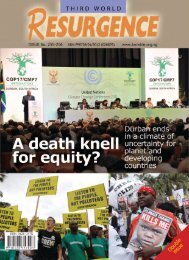Plantations, poverty and power - Critical Information Collective
Plantations, poverty and power - Critical Information Collective
Plantations, poverty and power - Critical Information Collective
You also want an ePaper? Increase the reach of your titles
YUMPU automatically turns print PDFs into web optimized ePapers that Google loves.
29<br />
2. The anatomy of five pulp projects<br />
This section looks at how five pulp projects in Brazil, Swazil<strong>and</strong>, Thail<strong>and</strong>, Indonesia <strong>and</strong> Uruguay were<br />
built, where the financing came from <strong>and</strong> what the impacts were for local people.<br />
Veracel, Brazil: A failed <strong>and</strong> destructive model of “development”<br />
Veracel started up its massive new pulp in June 2005 near Eunápolis in the state of Bahia in Brazil. Two<br />
years later, almost 350 organisations <strong>and</strong> individuals signed on to a statement about the Veracel pulp mill<br />
<strong>and</strong> its plantations. The statement clearly explains what is wrong with this sort of project:<br />
“We consider that a company such as Veracel Celulose, one of the symbols of the ‘development’ model<br />
imposed in an arbitrary, illegal <strong>and</strong> violent way, giving rise to serious negative consequences <strong>and</strong> causing<br />
violence, <strong>poverty</strong> <strong>and</strong> hunger to the people of the Extreme South of Bahia, cannot be environmentally<br />
responsible, socially beneficial or economically viable.<br />
“For the traditional peoples <strong>and</strong> member organizations of the Socio-Environmental Forum of the Extreme<br />
South of Bahia <strong>and</strong> the Alert against the Green Desert Network, large-scale monoculture eucalyptus<br />
plantations are ecologically disastrous, socially unjust <strong>and</strong> economically perverse for the region.” 104<br />
The 900,000 tonnes a year pulp mill cost US$1.25 billion <strong>and</strong> was built with financing from the European<br />
Investment Bank (EIB), the Nordic Investment Bank <strong>and</strong> Brazil’s development bank (BNDES). 105<br />
The company is a joint venture between two giants of the pulp <strong>and</strong> paper industry: the world’s largest<br />
producer of paper, Stora Enso (Finl<strong>and</strong>-Sweden), <strong>and</strong> the world’s largest producer of bleached eucalyptus<br />
pulp, Aracruz (Brazil). Pulp from the mill is to be exported, mainly to Europe, the USA <strong>and</strong> Asia.<br />
Veracel planted its first eucalyptus tree in May 1992 106 <strong>and</strong> construction of the pulp mill started eleven<br />
years later. 107 Before the pulp mill was constructed, eucalyptus from Veracel’s plantations was shipped to<br />
Aracruz’s pulp mills in Espirito Santo.<br />
The Veracel project is part of Stora Enso’s plans to move a large part of its production to the Global<br />
South. In May 2005, Kari Vainio, executive vice-president of communications at Stora Enso, told the<br />
Financial Times, “With time, production will shift from North America <strong>and</strong> Sc<strong>and</strong>inavia to the southern<br />
hemisphere.” 108<br />
Veracel already has plans to exp<strong>and</strong>. According to Pulp <strong>and</strong> Paper International magazine, much of the<br />
104 “Arguments to show that Veracel should not receive certification”, Letter sent to FSC to show that Veracel should<br />
not receive certification, 14 August 2007, signed by 347 organisations <strong>and</strong> individuals.<br />
http://www.wrm.org.uy/countries/Brazil/Letter_Veracel.html<br />
105 Måns Andersson <strong>and</strong> Örjan Bartholdson Swedish Pulp in Brazil: The case of Veracel, Swedwatch, 2004, page 5.<br />
http://www.swedwatch.org/swedwatch/content/download/157/721/file/Rapport%20Swedwatch.Vercel.pdf<br />
106 Veracel (2002) “Veracel 10 years”, Veracel company booklet, 2002.<br />
107 Måns Andersson <strong>and</strong> Örjan Bartholdson Swedish Pulp in Brazil: The case of Veracel, Swedwatch, 2004, page 24.<br />
http://www.swedwatch.org/swedwatch/content/download/157/721/file/Rapport%20Swedwatch.Vercel.pdf<br />
108 Raymond Colitt (2005) “Brazilian plant may prompt lower pulp prices”, Financial Times, 27 May 2005.















